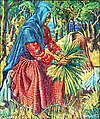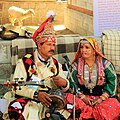Gaddis
The Gaddi is a semi-pastoral Indo-Aryan ethno-linguistic tribe living mainly in the Indian states of Himachal Pradesh and Jammu and Kashmir.[citation needed]


Overview[edit]
The people of Gaddi tribe living mainly in the India states of Himachal Pradesh in Bharmour region , District Chamba .
The term Gaddi is derived form Sanskrit word 'Gabdika' which is a sindhvadi janapad menitoned by Panini ,which later on during the reign of sahil verman ( 700ce) termed as "Gadbika-aheran" in todays it is spelled as gaddheran .
Some believe that people migrated during Mughal Muslim reign due to the fear of conversion of their religion.
People of Bharmour and Holi region are firm believer of Goddess 'ADI SHAKTI' AND 'Lord SHIVA'.
GADDI ARE DIVIDED INTO TWO CASTE[edit]
Brahmins(GADDIS)-
The majority of them have migrated to Brahmaur in the reign of King Meru Varman. They wear the sacred thread and act as priests and purohits. When the capital was shifted: to Chamba, they lost the state patronage and took to other professions. The common gotras of Brahmins are Vashisht, Bhardwaj and Gautam. These gotras are, however, divided into various als which are sometimes incorrectly described as gotras also such as Dharakru Langhe, Phangtain and Sipainu. Brahmins generally marry within their own caste though intercaste marriages with Rajputs have been recorded. Unlike the Brahmins of the lower hills, or the plains, the Brahmins of Brahmaur do not marry into their own gotras.Thus there is a bar to the solemnisation of a marriage of a' Vashisht boy with a Vashisht girl. Their mutual form of salutation is namaskar while from others it is pairi pauna to which the reply is asis banchna. The hill Brahmins are, by and large, non-vegetarians and so are the Brahmins of Brahmaur.
Kashatriya-Rajput(GADDIS)-[edit]
They are the Hindu warriors class and belong to Indo-Aryan race. They wear the janeu. And are firm believer of Lord SHIVA'.The common form of salutation among the Rajputs gaddis is 'Jai Jaiya' to one another. They receive it from others and respond with Ram Ram. The ancient occupation of the Rajputs was sheep rearing and agriculture and it is they who possess the largest number of sheep and goats, are generally very rich and well-off. With the developing world and socio economic upliftment of this tribal area i.e bharmour the occupational trends of people living here have been changed. People now have got migrated to plains and are working at some of the highest reputed post in government institutions. The Rajputs are of different gotras like Gautam, Bhardwaj, kaundal etc, with sir names mainly as Kapoor, Thakurs, Rana and Chauhan etc. Their rituals and clan orders are strict. They marry among their own caste and have no inter-gotra marital relations .
Today due to the Climatic adversities of the location and backwardness of the tough Himalayan terrain area and lack of facilities, they are considered under the "Scheduled Tribe" in the Constitution of India.
According to the 2011 Census of India, the Gaddi population was 1,78,130 in Himachal Pradesh and 46,489 in Jammu Kashmir. The Gaddis of Himachal Pradesh had an adult sex ratio of 1014 and literacy rate of 73.3, whereas those of Jammu and Kashmir had a sex ratio of 953 and literacy of 53.5. reservation system.[1]
Gaddis' traditional practices and habits are changing rapidly with India's modernisation.[2]
Gallery[edit]
-
Gaddi woman mowing, Alfred Hallett c. 1980
-
Gaddi men near Dharamshala, 1980
-
Gaddi artisans at Suraj Kund fest
References[edit]
- ^ "Statistical Profile of Scheduled Tribes in India" (PDF). Registrar of Census, Government of India. p. 170. Retrieved 1 May 2019.
- ^ Simpson, Nikita (29 May 2023). "Ghar ki tension : domesticity and distress in India's aspiring middle class". Journal of the Royal Anthropological Institute. 29 (3): 573–592. doi:10.1111/1467-9655.13956. ISSN 1359-0987.
Further reading[edit]
- Verma, V. 1996. Gaddis of Dhauladhar: A Transhumant Tribe of the Himalayas. Indus Publishing Company, New Delhi.



